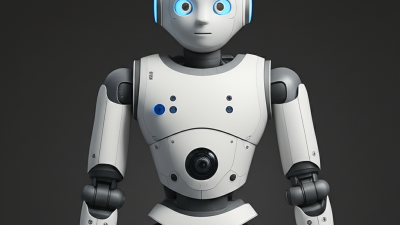How to Choose the Best Humanoid Robot for Your Business Needs
As the demand for automation and customer engagement technology steadily grows, businesses are increasingly turning to Humanoid Robots to enhance operations and offer innovative services. According to a report by Fortune Business Insights, the global humanoid robots market is expected to reach $1.98 billion by 2026, growing at a CAGR of 38.6% from 2019 to 2026. This significant growth can be attributed to advancements in artificial intelligence, machine learning, and robotics, allowing humanoid robots to perform complex tasks alongside human workers. However, with a plethora of options available in the market, selecting the best humanoid robot tailored to specific business needs can be challenging. This blog aims to guide you through the considerations and examples that will help you make an informed decision, ensuring that your investment in humanoid technology aligns with your strategic objectives.
Factors to Consider When Selecting Humanoid Robots for Workplace Automation
When selecting a humanoid robot for workplace automation, several critical factors must be considered to ensure that the chosen technology aligns with your business needs.
First, it’s essential to evaluate the robot’s capabilities in terms of task performance and adaptability. According to a report from MarketsandMarkets, the global service robotics market is expected to reach $37.5 billion by 2025, indicating a significant demand for robots that can seamlessly integrate into various industries.
Understanding the specific tasks that the robot will handle—be it customer interaction, logistics support, or data management—will guide businesses to select models that exhibit the relevant skills and functionalities.
Another vital aspect to consider is the robot's ease of integration with existing systems and infrastructure. A study by ResearchAndMarkets suggests that 70% of businesses face challenges in achieving interoperability with robotic solutions. Therefore, it is crucial to opt for humanoid robots that come with flexible software capabilities and can integrate with current IT frameworks.
This not only enhances operational efficiency but also minimizes downtime and training efforts. Additionally, assess the support and maintenance services offered by the manufacturer, as ongoing technical assistance is vital for long-term success and sustainability in automation efforts.
Industry-Specific Applications of Humanoid Robots in Retail and Customer Service
As businesses increasingly integrate technology into their operations, humanoid robots are emerging as valuable assets in both retail and customer service sectors. A report by the International Federation of Robotics highlights that the retail robotics market is projected to grow at a compound annual growth rate (CAGR) of 21% through 2025. This surge underscores the effectiveness of humanoid robots in enhancing customer interaction, streamlining operations, and improving service quality.
In retail environments, humanoid robots are being deployed to assist customers with product information, guide them through store layouts, and even manage inventory. According to a study by Deloitte, 58% of customers reported that they preferred shopping in stores that utilized robotic assistants because of the increased efficiency and interactive experience.
Similarly, in customer service roles, robots like SoftBank's Pepper have demonstrated their ability to handle inquiries, resulting in a 30% reduction in response times. This level of efficiency not only enhances customer satisfaction but also allows human employees to focus on more complex tasks that require personal touch and creativity.
The Impact of Humanoid Robots on Operational Efficiency in Manufacturing
The integration of humanoid robots in manufacturing has been transforming operational efficiency, offering significant advantages that are hard to overlook. Research by the International Federation of Robotics (IFR) indicates that in 2023, the stock of industrial robots worldwide surpassed 3 million units, with humanoid robots increasingly taking center stage. These robots are designed to mimic human actions, allowing them to perform complex tasks alongside human workers. This synergy can lead to productivity enhancements of up to 20%, as noted in a recent study by McKinsey & Company.
Moreover, humanoid robots can operate continuously without the need for breaks, which dramatically reduces downtime and maintains consistency in production rates. According to a report from PwC, organizations leveraging humanoid robots have reported a 15% decrease in operational costs due to increased efficiency and reduced errors. As the industry moves towards higher automation, selecting the right humanoid robot tailored to specific business processes can further optimize resources and enhance overall output, proving to be an invaluable investment in a competitive marketplace.
How to Choose the Best Humanoid Robot for Your Business Needs - The Impact of Humanoid Robots on Operational Efficiency in Manufacturing
| Feature |
Description |
Impact on Efficiency |
Cost (USD) |
| Robotics Navigation |
Ability to navigate through the manufacturing floor |
Reduces time spent on pathfinding by 30% |
20,000 |
| Product Assembly |
Capable of assembling parts with precision |
Increases assembly speed by 25% |
35,000 |
| Quality Inspection |
Uses sensors to detect defects |
Improves quality control efficiency by 40% |
15,000 |
| Interactive Employee Assistance |
Provides assistance and training to workers |
Enhances employee productivity by 20% |
30,000 |
| Data Analytics |
Collects and analyzes manufacturing data |
Provides insights to improve processes by 35% |
25,000 |
Evaluating the Cost-Effectiveness of Humanoid Robots Across Different Sectors
When evaluating the cost-effectiveness of humanoid robots across different sectors, it is essential to consider both initial investment and long-term operational savings. In industries like healthcare, humanoid robots can assist with patient management, reducing the need for additional staff and lowering overhead costs. By automating routine tasks such as scheduling and basic patient interaction, hospitals can enhance efficiency and prioritize human resources for critical care activities.
In the retail sector, humanoid robots have the potential to revolutionize customer service and inventory management. By deploying robots that can engage customers and provide real-time assistance, businesses may see an increase in customer satisfaction and loyalty. Moreover, humanoid robots can reduce labor costs and optimize inventory tracking, ultimately contributing to a more streamlined operation. As businesses explore these innovative technological solutions, a thorough analysis of the expected return on investment becomes crucial to determine which humanoid robots can provide the most value based on specific business needs.
Emerging Trends in Humanoid Robot Technology and Their Business Implications
Emerging trends in humanoid robot technology are reshaping the landscape for businesses across various sectors. According to a report by MarketsandMarkets, the global humanoid robot market is projected to reach $4.5 billion by 2026, growing at a CAGR of 57% from 2021. This growth is driven by advancements in AI, machine learning, and robotics, enabling humanoid robots to perform complex tasks, enhance customer interactions, and streamline operations. As these technologies evolve, businesses must stay informed about the capabilities these robots offer, such as real-time data processing and improved customer service.
Tip 1: Consider the specific needs of your industry when choosing a humanoid robot. For example, retail businesses may benefit from robots that enhance customer engagement, while manufacturers might focus on robots with superior automation and precision capabilities.
The implications of humanoid robot technology extend beyond just operational efficiency. A report from Gartner predicts that by 2025, 30% of customer service interactions will be handled by intelligent machines. This shift highlights the importance of integrating humanoid robots into customer-facing roles to improve user experiences and optimize resource allocation.
Tip 2: Evaluate the user-friendliness and adaptability of humanoid robots. Choose models that can be easily programmed and customized to align with your business processes, ensuring a smooth integration and maximum return on investment.









